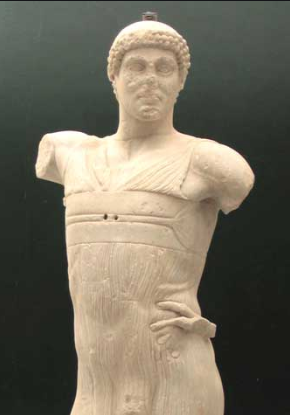The expressive statue of a young man in a finely-pleated linen tunic, Il Giovane di Mozia, was found at Cappiddazzu on the northeast side of the island of Mozia (the ancient Phoenician Motya) in 1979. In the stance of a victor, with hand on hip, the pose of the statue expresses great confidence in his youth, beauty and power. This remarkable work, made of white marble and dating from the 5th century BC, is thought to be by a Greek artist. It was found buried under a layer of rubble, face up in the road by the sanctuary. The face and the front are abraded, possibly from when the bronze accoutrements were torn from the statue during the attack of 398 BC by Dionysius I of Syracuse. When the statue was loaned to the British Museum in London for the duration of the 2012 Olympic Games, it was universally referred to as ‘The Motya Charioteer’. But this identification has not always been so certain. It is true that the work shares similarities with the famous charioteer of Delphi. But there have been numerous other theories: one suggests that the statue may represent Melqart, a Phoenician god and titular divinity of Tyre, identified by the Greeks as Heracles. He was probably wearing a lion’s skin made of bronze (which would have partially covered the head) and a bronze band around the chest—the holes where this would have been fixed can still be seen. Another theory suggests that the statue may represent an athlete, or an unknown Carthaginian hero. The fact that it was not recovered and replaced in a temple, in spite of its enormous value, would be explained if it indeed represented a god. The shocked survivors of the battle against Dionysius may have thought their god profaned and buried it where it was found. Perhaps. I haven’t seen any claims for Melqart recently. Certainly not since Brian Sewell, in the London Evening Standard, announced: “This standing figure, larger than life-size, broken off at the ankles, is a charioteer. His dress is no ordinary chiton, the standard male garment of the day, but one that falls full length to protect his body from the clouds of dust kicked up by horses’ hooves.” Whatever the truth, if you didn’t see it in London, get ye to Motya.







